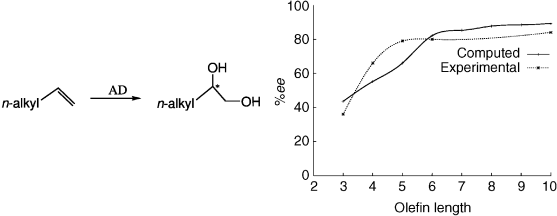The dihydroxylation of terminal aliphatic n-alkenes catalyzed by OsO4·(DHQD)2PYDZ ((DHQD)2- PYDZ=bis(dihydroquinidine)pyridazine) has been computationally studied by the hybrid QM/MM IMOMM- (Becke3LYP:MM3) method. The cases of propene, 1-butene, 1-pentene, 1-hexene, 1-heptene, 1-octene, 1-nonene, and 1-decene have been considered. A systematic treatment for the large number of possible conformations of the longer chain alkenes has been defined and applied, leading to the selection of approximately 1700 conformations to be computed. The IMOMM calculations of the transition states formed between these conformations and the catalyst generate enantiomeric excesses that closely resemble the experimental data of related systems, specifically in the preference for the R isomer and in its dependence on the chain length of the substrate. The selectivity increases sharply with the elongation of the short-chain alkenes until a ceiling value is reached, with further elongations having little effect on the enantiomeric excess (ee). These results are rationalized through the partitioning of the total energy of selected conformers, a process that leads to the identification of the most relevant regions of the catalyst and the characterization of the interactions critical for selectivity.
